Category Theory
Douban
Steve Awodey
Übersicht
Category theory is a branch of abstract algebra with incredibly diverse applications. This text and reference book is aimed not only at mathematicians, but also researchers and students of computer science, logic, linguistics, cognitive science, philosophy, and any of the other fields in which the ideas are being applied. Containing clear definitions of the essential concepts, illuminated with numerous accessible examples, and providing full proofs of all important propositions and theorems, this book aims to make the basic ideas, theorems, and methods of category theory understandable to this broad readership. Although assuming few mathematical pre-requisites, the standard of mathematical rigour is not compromised. The material covered includes the standard core of categories; functors; natural transformations; equivalence; limits and colimits; functor categories; representables; Yoneda's lemma; adjoints; monads. An extra topic of cartesian closed categories and the lambda-calculus is also provided - a must for computer scientists, logicians and linguists! This Second Edition contains numerous revisions to the original text, including expanding the exposition, revising and elaborating the proofs, providing additional diagrams, correcting typographical errors and, finally, adding an entirely new section on monoidal categories. Nearly a hundred new exercises have also been added, many with solutions, to make the book more useful as a course text and for self-study.
contents
CONTENTS
Preface to the second edition vii
Preface ix
1 Categories 1
1.1 Introduction 1
1.2 Functions of sets 3
1.3 Definition of a category 4
1.4 Examples of categories 5
1.5 Isomorphisms 12
1.6 Constructions on categories 14
1.7 Free categories 18
1.8 Foundations: large, small, and locally small 23
1.9 Exercises 25
2 Abstract structures 29
2.1 Epis and monos 29
2.2 Initial and terminal objects 33
2.3 Generalized elements 35
2.4 Products 38
2.5 Examples of products 41
2.6 Categories with products 46
2.7 Hom-sets 48
2.8 Exercises 50
3 Duality 53
3.1 The duality principle 53
3.2 Coproducts 55
3.3 Equalizers 62
3.4 Coequalizers 65
3.5 Exercises 71
4 Groups and categories 75
4.1 Groups in a category 75
4.2 The category of groups 80
4.3 Groups as categories 83
4.4 Finitely presented categories 85
4.5 Exercises 87
5 Limits and colimits 89
5.1 Subobjects 89
5.2 Pullbacks 91
5.3 Properties of pullbacks 95
5.4 Limits 100
5.5 Preservation of limits 105
5.6 Colimits 108
5.7 Exercises 114
6 Exponentials 119
6.1 Exponential in a category 119
6.2 Cartesian closed categories 122
6.3 Heyting algebras 129
6.4 Propositional calculus 131
6.5 Equational definition of CCC 134
6.6 λ-calculus 135
6.7 Variable sets 140
6.8 Exercises 144
7 Naturality 147
7.1 Category of categories 147
7.2 Representable structure 149
7.3 Stone duality 153
7.4 Naturality 155
7.5 Examples of natural transformations 157
7.6 Exponentials of categories 161
7.7 Functor categories 164
7.8 Monoidal categories 168
7.9 Equivalence of categories 171
7.10 Examples of equivalence 175
7.11 Exercises 181
8 Categories of diagrams 185
8.1 Set-valued functor categories 185
8.2 The Yoneda embedding 187
8.3 The Yoneda lemma 188
8.4 Applications of the Yoneda lemma 193
8.5 Limits in categories of diagrams 194
8.6 Colimits in categories of diagrams 195
8.7 Exponentials in categories of diagrams 199
8.8 Topoi 201
8.9 Exercises 203
9 Adjoints 207
9.1 Preliminary definition 207
9.2 Hom-set definition 211
9.3 Examples of adjoints 215
9.4 Order adjoints 219
9.5 Quantifiers as adjoints 221
9.6 RAPL 225
9.7 Locally cartesian closed categories 231
9.8 Adjoint functor theorem 239
9.9 Exercises 248
10 Monads and algebras 253
10.1 The triangle identities 253
10.2 Monads and adjoints 255
10.3 Algebras for a monad 259
10.4 Comonads and coalgebras 264
10.5 Algebras for endofunctors 266
10.6 Exercises 274
Solutions to selected exercises 279
References 303
Index 305